Reindeer Tracking Technologies in the Russian Federation
Автор: Khaimina L.E., Zelenina L.I., Khaimin E.S., Antufyev D.I.
Журнал: Arctic and North @arctic-and-north
Рубрика: Social and economic development
Статья в выпуске: 45, 2021 года.
Бесплатный доступ
Currently, reindeer husbandry actively uses tracking technologies to identify animals. They allow solving the problems of breeding and zootechnical accounting, tracking the movement of animals between herds, and carrying out antiepizootic measures. The electronic databases with individual characteristics of reindeer formed in this process allow speeding up the breeding process, organising breeding work in reindeer breeding, improving the breed and regulating the herd. Keeping an electronic “registration” of calves to their mothers gives the possibility of system functioning of cross-breeding estimation of animals that will undoubtedly increase both productivity and economic efficiency of reindeer breeding as a whole. This article addresses an issue related to reindeer tracking technologies. Attention is paid to radio tracking and satellite tracking techniques. The use of modern methods of chipping animals is considered on the example of various territories of the Russian Federation: the Yamalo-Nenets Autonomous Okrug, the Republic of Sakha (Yakutia), the Trans-Baikal Krai, the Murmansk Oblast, the Krasnoyarsk Krai, the Republic of Karelia, the Arkhangelsk Oblast. The work carried out on deer chipping is considered for various time periods, during which monitoring, programs, projects and other large-scale studies of animal movement paths were carried out. The resulting data can then be processed using mathematical tools, after which conclusions can be drawn about the impact of the environment on reindeer migration routes.
Reindeer, tracking technology, modern chipping method, satellite tracking
Короткий адрес: https://sciup.org/148323173
IDR: 148323173 | УДК: [004.722.45:636.294](985)(045) | DOI: 10.37482/issn2221-2698.2021.45.48
Текст научной статьи Reindeer Tracking Technologies in the Russian Federation
The procedure for marking and counting in reindeer husbandry was developed for the purpose of preserving the ancestral habitat and traditional way of life of the indigenous minorities of the North. Currently used Global Positioning System (GPS) collars have significantly improved research into the behaviour of livestock during grazing. Scientists Derek W. Bailey (New Mexico State University, Animal and Range Sciences Department, Las Cruces, NM USA), Mark G. Trotter (Central Queensland University, School of Medical and Applied Sciences, Rockhampton, QLD Australia), Colt W. Knight (University of Maine, Cooperative Extension, Orono, ME USA), Milt G. Thomas (Colorado State University, Department of Animal Sciences, Fort Collins, CO USA) noted that methods developed to improve grazing livestock pathways can now be tracked efficiently and cost-
effectively using GPS tracking. Ongoing research, according to scientists, has identified genetic markers that are linked to spatial movement patterns of cattle. Researchers argue that recent technological advances can make real-time or near-real-time pasture tracking possible and cost effective [1, p. 81].
The socio-economic effect of introducing GPS collars and adaptive forest management was also confirmed by researchers E. Valinger (Department of Forest Ecology and Management, Swedish University of Agricultural Sciences), S. Berg (European Forest Institute, Finland). T. Lind (Department of Forest Resource Management, Swedish University of Agricultural Sciences). The research was carried out in the Sami village of Nyarke in Boreal, Sweden. The authors noted that the use of GPS tracking allows the Sami to track the location and activity of the reindeer herd, which reduces the risk of accidents and incidents in the field and on the roads for both reindeer and people. Knowledge of the migration routes, as documented by the devices used, provides a better basis for rational management, as well as a basis for consultation with forest landowners in order to create better conditions for the development of reindeer husbandry [2, Valinger E., Berg S., Lind T., p. 941].
In Russia, reindeer husbandry has historically played a significant role for most of the indigenous peoples of the northern territories. In Circumpolar Russia, reindeer husbandry is a constitutional domain of indigenous peoples. V. Vladimirova (Institute for Russian and Eurasian Studies (IRES), Dept. Cultural Anthropology and Ethnology, Uppsala University) conducted an empirical study of the issues of selective breeding on the example of the Evenki reindeer herding enterprise in the village of Surinda, Evenki District, Krasnoyarsk Krai. The author considered the breeding process as a technology of power in Circumpolar Russia [3, p. 250].
Deer tracking technologies are currently widely used in the Russian Federation. Researcher V. Goncharov (Scientific-Research Institute of Agriculture and Ecology of the Arctic) studied the feasibility and effectiveness of implementation of electronic chipping RFID tags in reindeer breeding to identify animals on the example of the Krasnoyarsk Krai [4, p. 63]. The research of I.V. Seredkin is devoted to the introduction of radio telemetry methods for wildlife and satellite tracking programs in the Far East [5, p. 29].
Tracking technologies
The most commonly used deer tracking technologies are radio and satellite tracking.
Radio tracking is based primarily on the use of internal and external transmitters such as radio collars. A transmitter is used (attached or surgically implanted to animal) that sends a signal in the form of radio waves. The transmitter usually uses a frequency in the VHF range, the transmitted pulses are short. A radio direction finding (RDF) receiver gets the signal. The receiver has a directional antenna and a means of displaying the strength of the received signal. In order to track the signal, the scientist follows the animal (on an airplane or ATV) using a receiver.
Satellite tracking is based on a network or group of satellites, each receiving signals from a transmitter mounted on the animal. The combination of signals from all satellites allows not only to determine the location of the animal accurately, but also to track the path of the animal while it is moving. Animal transmitters can also provide data on the physiological characteristics (for example, temperature and habitat use). Satellite networks report territorial movements of animals. Tracking systems such as Argos and GPS are widely used to find the main habitats of moving animals.
Satellite tracking is also possible through the use of acoustic telemetry, which includes the implementation of electronic tags. In this case, the monitored animals are determined in three dimensions.
One of the modern methods of computer modeling of reindeer behaviour is chipping, which makes it possible to form electronic dossiers of animals, contributing to an increase in the efficiency of the operation of farms and reindeer husbandry in general.
This article provides an overview of the technologies used for tracking reindeer in various regions of the Russian Federation, aimed at studying the migration routes of reindeer, plotting data on a map of the investigated area, conducting biological and zoological analysis of the data obtained, analyzing the impact on the ecostructure of the studied territory.
Reindeer tracking in the Russian Federation The Republic of Sakha (Yakutia)
In March 2010, an experimental Argos system radio beacon was tested on domestic reindeer in Yakutia. In August 2010, wild reindeer (15 individuals) were equipped with radio beacons with built-in transmitting antennas of the Argos system, which made it possible to monitor the movements of animals [6, Salman A.L., Rozhnov V.V., p. 46] (Fig. 1).
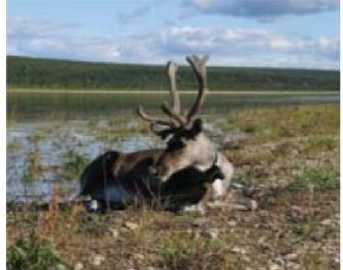
Fig. 1. Wild reindeer with an Argos collar [6, Salman A.L., Rozhnov V.V., p. 46].
Research on reindeer chipping continued, and in 2018, ALROSA Company, together with the Institute for Biological Problems of Cryolithozone SB RAS, monitored the movement of a herd of the Lena–Olenek population (Yakutia) of wild deer numbering about 90 thousand animals in the area of Udachninskiy MPP 1. The main purpose of the monitoring was to preserve the population of wild reindeer in the area of industrial diamond mining and to prevent the death of animals. Chipping of female deer was carried out using radio collars transmitting data on their location. The GLONASS satellite system used transmitted information about the deer's movement every 20 minutes. The installation of collars was painless for animals; the collar was automatically unfastened when the batteries ran out. As a result, a system was created to track the migration routes of wild reindeer in the area of the industrial enterprise, recommendations were developed to ensure the transition of reindeer on various sections of the road during the construction of the passage to the Verkhne-Munskoye field 2.
In 2018, LLC Information and Technical Center, having become a resident of the Yakutia Technopark, completed tests (conducted since 2012) of satellite collars for tracking a nomadic herd when detecting the hijacking of domestic reindeer by wild ones and minimising losses due to predator attacks. The satellite collar developers felt that it would be optimal to attach one collar for every 20 deer (for example, the herd leaders), in order to track and trace their movements on a geographical map. The developed satellite collars turned out to be well adapted to the conditions of the Arctic and are cheaper than foreign analogues 3.
Yamalo-Nenets Autonomous Okrug
In 2016, the Yamalo-Nenets Autonomous Okrug started using a modern method of chipping, which allows for cost-effective control of the deer population in the Priuralskaya tundra. An electronic clip on the ear of an animal allows to obtain information about the animal, its unique code (Fig. 2).
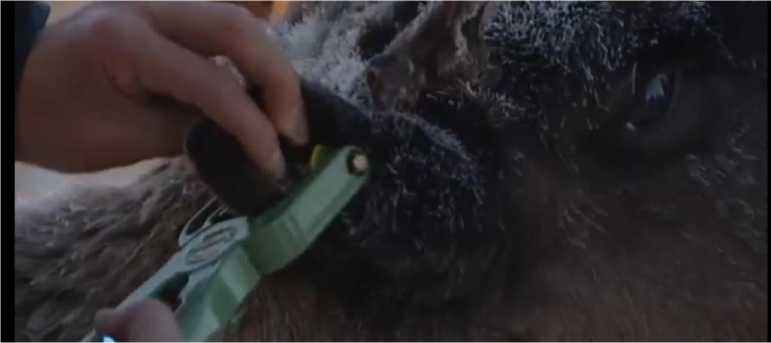
Fig. 2. The process of an electronic clip placing.
A scanner, put to the animal's ear, reads the information from the chip within a few seconds and transmits the necessary data, for example, who owns the deer (which herd, including private reindeer herders). The collected information on the chipped animal gets into an electronic database, which makes it possible to carry out zoo-technical work, determine the number of herds and grazing routes. The clipping chips are also convenient as they allow to solve the issue of counting the animals. Special frames are also used to read out the information 4.
As of 2020, 22 thousand deer have been “digitized” in the Yamalo-Nenets Autonomous Okrug. When an animal passes through the frame of a deer corral, the electronic tag in its ear makes it possible to find out the animal's dossier: weight, age, sex, vaccination and reprodu c-tive data. According to the developers, the volume of portfolio data can be increased in the future, for example, by introducing an option for weight control. Almost every fourth deer in Yamal has ordinary tags (224 thousand animals). Digital tags are more functional and informative. In addition, microchipping will make it possible to improve the quality of breeding by creating a system for the evaluation of cross-breeding of horned animals. In particular, the quality of offspring can better determine the evaluation of bulls-producers, it will be possible to assign cows to specific bulls-producers. It should be noted that the deer herd available in Yamal is considered to be the largest in the world in terms of the number of species: more than 770 thousand animals (in 2017), almost 900 thousand animals (in 2020) 5 (Fig. 3).
Livestock size
(Yamalo-Nenets Autonomous Okrug)
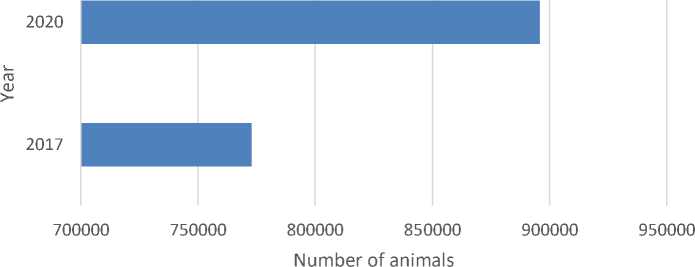
Fig. 3. Yamalo-Nenets Autonomous Okrug. Livestock size.
Republic of Karelia, Arkhangelsk Oblast (Vodlozerskiy National Park)
From 2017 to 2019, the Vodlozerskiy National Park and the “Beautiful Children in the Beautiful World” Charity Fund implemented the project “In the footsteps of a reindeer”, aimed at preserving the symbol of the northern taiga — the forest reindeer — on the territory of Vodlozerskiy Park (Fig. 4).
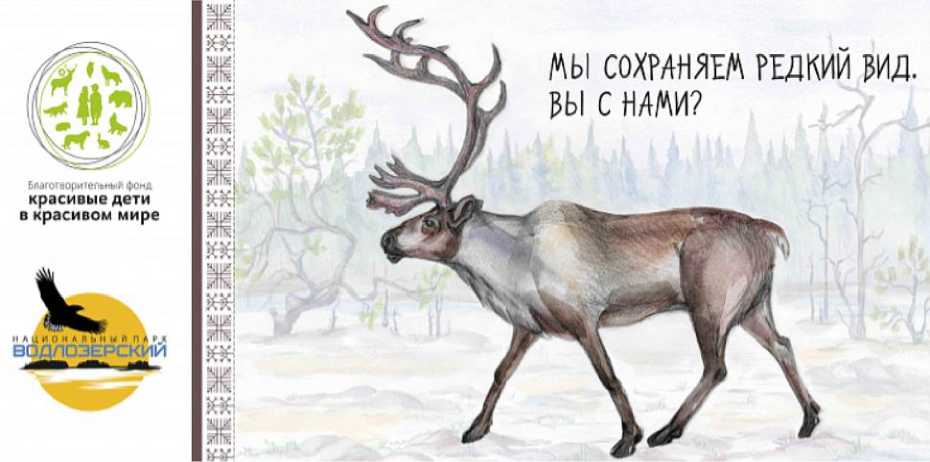
Fig. 4. Project “In the footsteps of a reindeer”.
Remote observation of animals by scientists of the Park made it possible to obtain information about the places of their concentration, the ways of deer’s movement, the number and structure of herds, and seasonal peculiarities of animals' behaviour. The work was focused on prevention poaching (planning patrol protection routes) and death of deer from predators (prompt detection of wolves in the areas under consideration). All of the planned and conducted activities were aimed at preserving the forest reindeer isolated in the park, and analysing the number and structure of herds and their migration routes. Within the framework of this project, an expedition was carried out in a part of the park located in the Arkhangelsk Oblast. Scientists installed GPS collars on the deer using the author's method of V. Mamontov, the head of the scientific department of Vodlozerskiy park: trap loops were installed on the path of the reindeer movement at a height of 1.2 meters, so as not to harm the animal. After the project was over, the work on wild reindeer conservation is being successfully continued 6.
Zabaykalskiy Krai
In 2019, in the north of Zabaykalie (in the Kalarskiy District), the counting of reindeer began in Evenk reindeer herding farms with a livestock of about 3.5 thousand reindeer. Chipping has become a modern method of counting animals. After vaccination, a reindeer is pierced in the ear
6 Proekt «Po sledam severnogo olenya» [Project "In the footsteps of a reindeer"]. URL: (accessed 02 April 2021).
with an electronic clip, containing information on the identification number, sex and age group of the animal, data on its owner. Electronic identification of domestic reindeer made it possible to maintain a database on the number and structure of the herd, which, in turn, helped to develop support measures together with LLC “Baikal Mining Company”, including traditional nature management of Evenks within the subprogramme “Support for indigenous and minority peoples of the Far North”, launched in Zabaikalskiy Krai in 2019. Within the framework of the program, the regional public organization “Association of Indigenous Minorities of the North” purchased equipment for the electronic identification of domestic reindeer: a set of ET 30 FDX electronic ear tags; universal applicators-irrigators for installation of all types of ear tags; a PR-520B manual reader (fig. 5). The chip is injected into the reindeer for life. It will report information about the animal throughout its life 7.
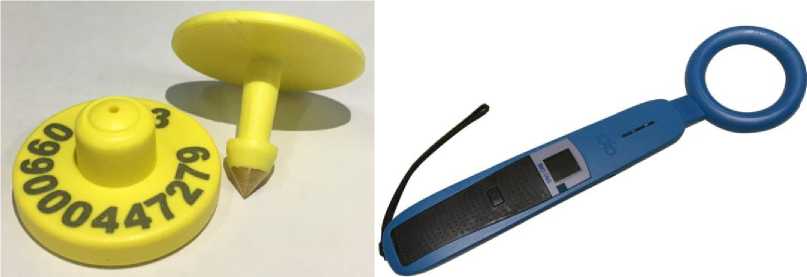
Fig. 5. The ET30 FDX-B electronic tag and the PR-520B electronic tag reader.
Information received from chipped animals can be stored and processed in automated systems. Regional center for information support of livestock breeding “Plinor” implements the information and analytical system “SELEX. Reindeer”, which is a software product for storage and analysis of the data on animals, monitoring of the main production indicators of reindeer breeding (Fig. 6). At the same time, available database allows to conduct not only individual registration of animals (events in the life of a deer from birth to death are recorded: weighing, assessment of conformation, bonitering, assignment, arrival, insemination, calving, veterinary treatments, movements), but also group registration, which makes it possible to record data on the presence and movement of the livestock without identifying each animal. Annual, semi-annual and intermediate counts of the livestock are formed. It is possible to record departures, additions, calving, castration, chipping, movement, veterinary treatment of groups of animals.
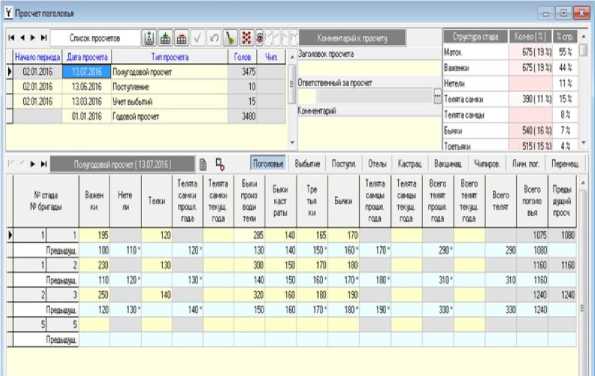
Fig. 6. Data processing in “SELEX. Reindeer” system 8.
Krasnoyarsk Krai
In 2015, Krasnoyarsk began to use unique satellite collars to track the movement of Evenk wild reindeer (produced by the Russian company ES-PAS). Some of the collars were equipped with radio beacons of the ARGOS satellite system, while others had built-in GPS receivers (Fig. 7). The data obtained made it possible to determine the location of the animal with an accuracy of 100 meters .
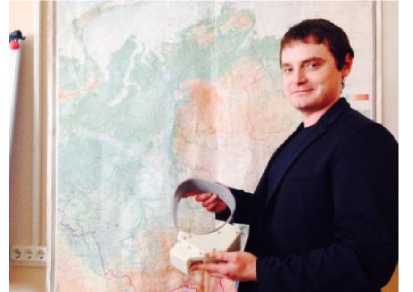
Fig. 7. Satellite collars for tracking the location of wild deer, developed by specialists of the Russian company ES-PAS.
A project to study wild reindeer, carried out by university scientists in cooperation with the East Siberian Oil and Gas Company, which is developing the Yurubcheno-Tokhomskoye field in the southern part of Evenkiya, has provided new data on animals' movement 9.
In 2019–2020, domestic reindeer in Krasnoyarsk Krai were chipped (electronically tagged), which made it possible to assess the veterinary welfare of herds. The total number of domestic reindeer in the Krasnoyarsk Krai was about 120 thousand in September 2020 10.
-
8 Information-analytical system "SELEKS.Deer". URL: (accessed 04 April 2021).
-
9 Uchenye pokazali unikal'nye osheyniki dlya otslezhivaniya migratsii evenkiyskikh oleney [Scientists have shown unique collars for tracking the migration of Evenk deer]. URL: https://newslab.ru/news/641777 (accessed 20 March 2021).
-
10 V Krasnoyarskom krae chipiruyut domashnikh severnykh oleney [Domestic reindeer are microchipped in the Krasnoyarsk Krai]. URL: https://regnum.ru/news/society/3056520.html (accessed 20 March 2021).
According to the Agency for Development of Northern Territories and Support of Indigenous Minorities of Krasnoyarsk Krai, from 2021, reindeer herders will receive support only for chipped reindeer 11.
In 2020, in order to preserve the population in the Krasnoyarsk Krai, wild reindeer were tagged with satellite collars. The collars had built-in GPS / GLONASS receivers. With the help of this satellite system, specialists will be able to constantly track the movement of reindeer, determine the places of their concentration and wintering. The collars were put on deer that live in the Evenk and Turukhansk regions, and on Taimyr territory 12.
It should be noted that since 2014, the authorities have not conducted population assessments or monitored the locations of the Taimyr wild reindeer population. At that time, the livestock population was found to be down to 417 thousand reindeer, which is 26% lower than in 2009 13 (Fig. 8).
Taimyr population of wild reindeer
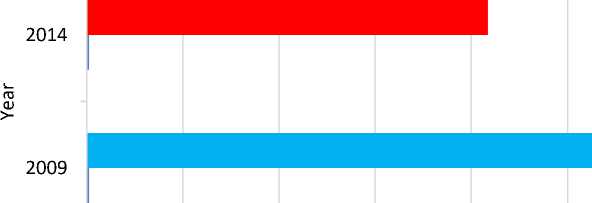
0 100000 200000 300000 400000 500000 600000
Number of animals
Fig. 8. Taimyr population of wild reindeer, 2009–2014.
In 2020, Rosneft Company began studying Arctic animals, including reindeer, to assess the sustainability of ecosystems. In the period up to 2023, within the framework of the program, eight expeditions will take place in the Laptev, Barents and Kara Seas. They will be attended by scientists from the A.N. Severtsov Institute of Ecology and Evolution, Arctic and Antarctic Research Institute and Siberian Federal University. This work is a continuation of the large-scale studies of polar bears, walruses and reindeer conducted in 2014–2018 14.
Murmansk Oblast
Since 2018, a new method of chipping has been used in the Murmansk Oblast: a reindeer is injected with a sensor on which information about the animal is recorded via a scanner: gender, nickname, number, color, age of vaccination, migration routes. In the future, the information is transferred to a single database for registration and accounting. Information about the animal is read out using a mini-computer. The chip used functions as long as the animal lives (on average, 15–20 years). Previously, the chips were injected with a syringe, or the animals were tagged. Over time, the sensor will provide information on the extent to which the age of the animal and its weight has increased. It is therefore a kind of electronic passport 15.
Conclusion
Thus, deer tracking technologies are widely used in the Russian Federation. At the same time, methods of capturing animals and technologies for installing chips are being improved. The result of chipping is the collection of information about the reindeer's behaviour. On the basis of the collected data, information and analytical systems are being developed for storing and analysing information on chipped animals. The data obtained can be processed by the methods of mathematical tools; the conclusions formed in this process make it possible to establish the influence of the environment on the reindeer migration routes and the spatial and temporal interactions between the animals.
The use of modern methods and technologies for tracing reindeer will undoubtedly lead to an increase in the economic efficiency of both individual reindeer herding farms and reindeer husbandry in general, which plays a significant role in the life support of the peoples of the North.
The development of this scientific topic at the international level is possible, for example, in the context of the COLARCTIC project “Breakthrough information technologies for BEAR”, which, in particular, solves the development of IT services in reindeer husbandry by partners from Russia, Sweden, Norway and Finland 16.
Список литературы Reindeer Tracking Technologies in the Russian Federation
- Bailey W., Trotter M.G., Knight C.W., Thomas M.G. Use of GPS Tracking Collars and Accelerometers for Rangeland Livestock Production Research. Translational Animal Science, 2018, vol. 2, iss. 1, pp. 81–88. DOI: 10.1093/tas/txx006
- Valinger E., Berg S., Lind T. Reindeer Husbandry in a Mountain Sami Village in Boreal Sweden: the So-cial and Economic Effect of Introducing GPS Collars and Adaptive Forest Management. Agroforest Syst., 2018, vol. 92, pp. 933–943. DOI: 10.1007/s10457-018-0249-z
- Vladimirova V. Technologies of Modern Reindeer. Breeding as Technologies of Power in Circumpolar Russia: a Study of Selective Breeding of Evenki Reindee. Norsk Antropologisk Tidsskrift, 2020, vol. 31, pp. 249–267. DOI: 10.18261/issn.1504-2898-2020-04-02
- Goncharov V.V. K voprosu chipirovaniya v olenevodstve Krasnoyarskogo kraya [On the Issue of Chip-ping in Reindeer Husbandry of the Krasnoyarsk Territory]. In: Sbornik nauchnykh trudov «Biolog-icheskie resursy Kraynego Severa: sovremennoe sostoyanie i ratsional'noe ispol'zovanie» [Collection of Scientific Papers "Biological Resources of the Far North: Current State and Rational Use"]. Saint Petersburg, GNU Nauchno-issledovatel'skiy institut sel'skogo khozyaystva Kraynego Severa Publ., 2014, pp. 62–67.
- Seredkin I.V. Primenenie radiometrii i sputnikovogo slezheniya dlya izucheniya territorii dikimi zhivotnymi na Dal'nem Vostoke Rossii [Application of Radiometry and Satellite Tracking for the Study of the Territory by Wild Animals in the Far East of Russia]. In: Arealy, migratsii i drugie peremeshcheniya dikikh zhivotnykh. Materialy mezhdunarodnoy nauchno-prakticheskoy konferentsii [Areas, Migrations and Other Movements of Wild Animals. Proc. Int. Sci. Pract. Conf.]. Vladivostok, 2014, pp. 292–299.
- Salman A.L., Rozhnov V.V. Ispol'zovanie sputnikovoy sistemy Argos dlya nablyudeniya za zhivotnymi na territorii Rossii [Application of Argos Satellitebased System for Tracking Animals in Russia]. Zem-lya iz kosmosa: naibolee effektivnye resheniya [Earth from Space], 2010, no. 7, pp. 42–47.

